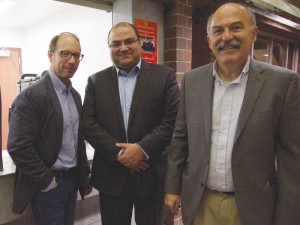Aramayis Orkusyan
Editor

Photo: Hourig Attarian
The Young Turk Revolution was a critical point in the history of not only the Ottoman Empire, but also the history of the Armenians. This pivotal year was the topic of a lecture by Dr. Bedross Der Matossian titled “The Political Culture of the Young Turk Revolution of 1908: Space, Symbolism, and Language” presented on Friday, October 30.
The lecture was part of the Armenian Studies Program Fall 2015 Lecture Series, with the support of the Virginia-based Ararat Foundation, founded in 1985, which promotes Armenian culture and Christian faith, through lectures on Armenian subjects, seminars, literature distribution, and research.
“I was always interested in the history of the Ottoman Empire, specifically that of the Armenians, and eventually I developed an interest in ethnic relationships there between Armenians, Arabs, and Jews” stated Der Matossian, who was born in the Muslim Quarter of the Old City of Jerusalem. Der Matossian’s interests led him to pursue his undergraduate and master’s degrees in the Department of Islamic and Middle Eastern Studies at the Hebrew University, and subsequently a Ph.D. in Middle East History in the Department of Middle Eastern, South Asian, and African Studies at Columbia University in 2008. Currently, he is an assistant professor of history at the University of Nebraska, Lincoln.
The Young Turk Revolution marked the restoration of the Ottoman Constitution of 1876 and the beginning of the abolition of the Ottoman authoritarian regime. Highlighting the significance of this period, Der Matossian stated “I see [the revolution] as a major turning point in not only the history of the Ottoman Empire, but also in modern Middle Eastern history. It was the last hope the Ottoman empire had to revive itself from the reign of Abdul Hamid II.”
All ethnic groups of the Ottoman Empire expressed euphoria after the revolution. Der Matossian’s lecture concentrated on demonstrating how the post-revolutionary feeling manifested itself in these different ethnic groups through celebration and festivities. Among the ethnic groups that participated in these activities, and the focus of Der Matossian’s talk, were the Armenians.
In response to the news of the new constitutional regime, Armenians in the provinces decorated their streets and houses, and masses gathered in Armenian churches and cemeteries in celebration of what was believed to be a change for the better. “For the Armenians, the Young Turk Revolution was very important,” stated Der Matossian. “Their hopes were very high, specifically the hopes of the Armenian Revolutionary Federation. They thought that this would be a new page in the history of the Ottoman Empire, and that they were going to live in peace and serenity.”
This, however, turned out not to be the case. As Der Matossian argued in his lecture “the revolutionary festivities were contradictory to the idea of the revolution itself.” The revolution aimed to create an “Ottoman citizen” and a centralized government, yet the festivities celebrated the hope for administrative decentralization and freedom to maintain privileges and ethnic diversity.
Der Matossian’s lecture was based on a chapter of his book Shattered Dreams of Revolution: From Liberty to Violence in the Late Ottoman Empire, in which he meticulously studied the Young Turk Revolution by reflecting the public opinion and reaction of the “non-dominant” ethnic groups of the Ottoman Empire. Published by the prestigious Stanford University Press in 2014, Dr. Der Matossian’s book has received positive reviews from major scholars in the field.
Although other scholars study the Young Turk Revolution, “they have tended to view the Revolution from the center—meaning through the prism of the Young Turks,” commented Der Matossian. “Extensive research has been done from the dominant perspective, but very little has been done from the perspective of the non-dominant groups; and even when this research has been done, it tended to concentrate on one ethnic group.”
Der Matossian brings novelty to the field by bringing to life the multiple voices of different ethnic groups (Armenian, Arabs, Jews, and Turks) and analyzing the revolution from the perspective of each of these groups.
Dr. Der Matossian is now studying the Adana Massacres of 1909, which will be the topic of his next book.
 Hye Sharzhoom Armenian Action
Hye Sharzhoom Armenian Action